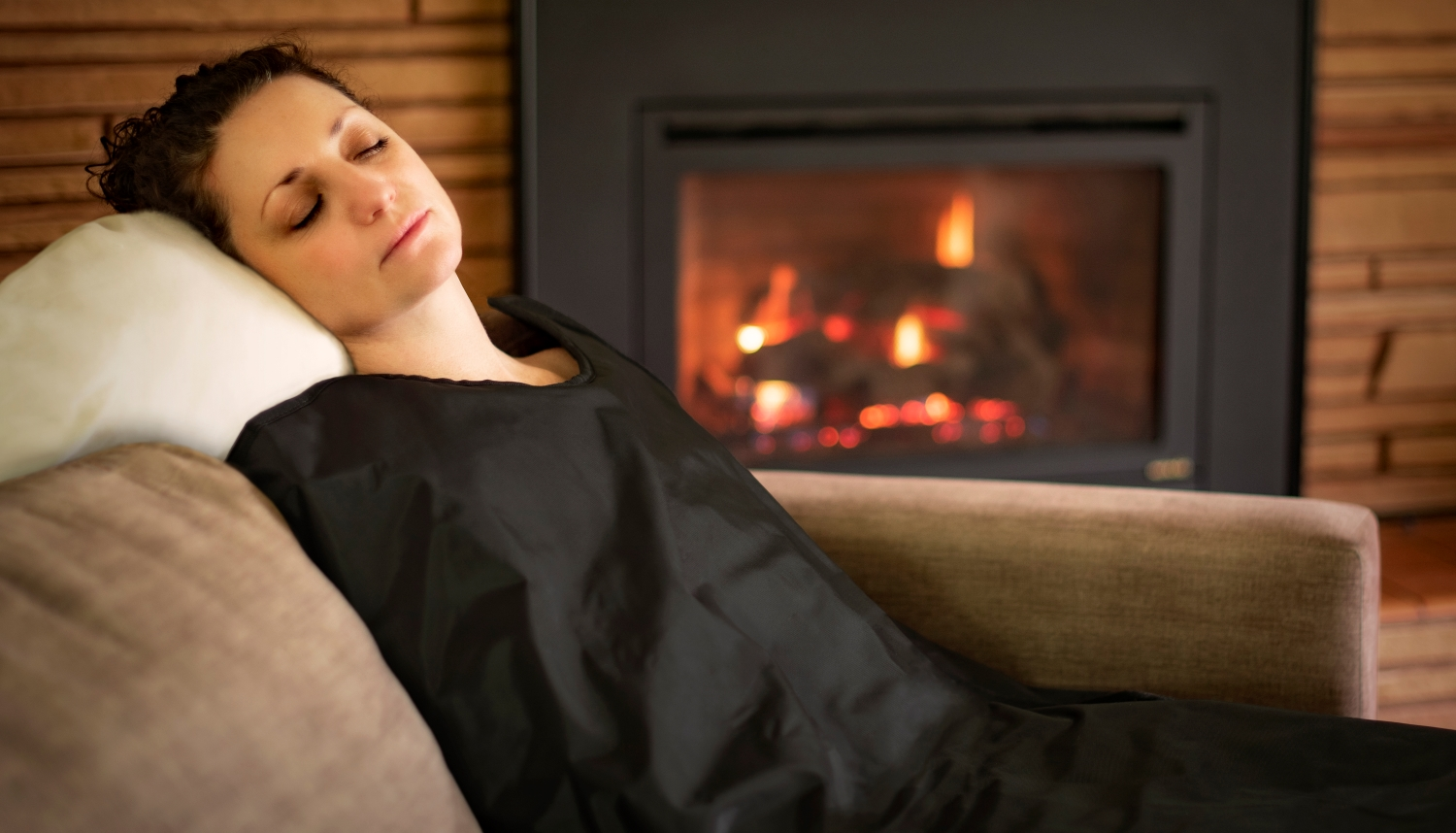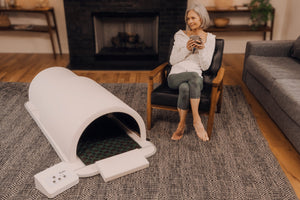Home Sauna Buyers Guide
Key Takeaways:
-
Find the type of sauna that works for you.
-
Infrared is the best way to go for most people.
-
Portable infrared saunas make at home sauna use a breeze
-
There are some important key factors when choosing an at home sauna and they are all discussed here.
When considering to purchase a sauna for home use, there will be many factors such as type of sauna, size of sauna, maximum temperature range, portability types of heating elements, as well as some other factors. Buying an at home sauna can be a large investment, but this investment will allow you to leverage several health benefits, as well as convenience.
Types of Saunas
Traditional Saunas

-
Temperature Range: 176-212℉ minimum (For optimal health benefits).
-
Sizing: Large.
-
Capacity: 1-4 Person sauna generally.
-
Indoor vs Outdoor: Area should not be vulnerable to moisture, if you choose an indoor sauna, the area should be protected from any moisture the sauna could excrete.
-
Portability: Semi-permanent.
-
Cost: Generally, most will be very high cost. $5,000-12,000
Traditional dry saunas, or Finnish style saunas, typically incorporate pouring water onto hot rocks to heat the air around your body. This creates a hot and humid atmosphere for your entire body to absorb the heat and humidity.
This style of sauna generally comes at quite a high cost, and can require a large space commitment. Some of the best traditional dry saunas can come at premiums of even $10,000 for some of the highest quality.
These saunas do often look beautiful, but may not create the most optimal environment for health benefits of sauna use, simply because of shallowness of heat penetration.
Infrared Saunas (Cabin-Style)

-
Temperature Range: 120-140℉ minimum (For optimal health benefits).
-
Sizing: Large.
-
Capacity: 1-4 Person sauna generally.
-
Indoor vs Outdoor: Personal preference. You will need an outlet to power the sauna, but these saunas are very dry so you will not need to worry about moisture and mold.
-
Portability: Semi-permanent.
-
Cost: This is largely based on the size and construction of the sauna. For a cabin-style, these will be closer to the price of traditional dry saunas. $1,800-9000
Infrared saunas can come in many different sizes. These saunas use far infrared rays or infrared heat, to heat the body directly, opposed to simply the air around you.
Infrared technology also allows you to benefit more from lower temperature ranges. Far infrared rays penetrate roughly 3 inches below the skins surface, this means that higher temperature ranges are not necessary to get the same benefits or rise in core temperature.
If you are someone who gets particularly uncomfortable from breathing in extremely hot air, far infrared saunas should be considered highly. A far infrared sauna also has the ability to raise your core temperature higher than a traditional sauna, so heat adaptation over time is not an issue.
Portable Infrared Saunas

-
Temperature Range: 120-140℉ minimum (For optimal health benefits).
-
Sizing: Small - Medium.
-
Capacity: Personal sauna
-
Indoor vs Outdoor: Personal preference. You will need an outlet to power the sauna, but these saunas are very dry so you will not need to worry about moisture and mold. Portable saunas allow you to even place them in your living room while relaxing and watching some TV.
-
Portability: Can be placed and stored anywhere you chose.
-
Cost: These saunas are very affordable for many people, oftentimes there are payments plans available. $1,400-3,000
Portable infrared saunas take advantage of all far infrared sauna sessions have to offer, but in a more compact package that can be placed anywhere within the home.
Many people often wonder if a portable infrared sauna can have the same health benefits of an infrared cabin-style sauna. Some of the best portable saunas do offer the exact same benefits that larger sized saunas do. This is simply because many of the benefits come from the elevation of core body temperature.
In some occasions a portable infrared sauna may even have more benefits than a larger cabin-style infrared sauna, since your body is closer to the heating elements, meaning you will absorb more far infrared.
Sauna Blankets

-
Temperature Range: 120-140℉ minimum (For optimal health benefits).
-
Sizing: Small.
-
Capacity: Personal sauna blanket
-
Indoor vs Outdoor: Personal preference. You will need an outlet to power the sauna, but these saunas are very dry so you will not need to worry about moisture and mold. Portable sauna blankets allow you to even place them in your living room while relaxing and watching some TV. These could even be placed on your couch or bed!
-
Portability: Can be placed and stored anywhere you chose.
-
Cost: These saunas are very affordable for many people, oftentimes there are payments plans available. $300-600
A infrared sauna blanket can be a great option for people looking to benefit from all that far infrared has to offer. Generally an infrared sauna blanket will have a slightly lower maximum temperature, but for ours in specific, this is still 176 degrees Fahrenheit which is plenty hot enough for health benefits and most people's tolerable heat levels.
In terms of portability, this may be the best portable option. You can essentially pack these up and take your sauna experience anywhere.
The cons of an infrared sauna blanket can relate to comfort. The materials these are made with are waterproof so the feeling of sweating while in total contact of the material, may not be fully desired. Important note: You will still receive all the benefits with an infrared sauna blanket that you would with a larger, cabin-style infrared sauna.
Traditional Steam Saunas

-
Temperature Range: 110-115℉ minimum (Health benefits of this are not the same).
-
Sizing: Large
-
Capacity: 1-4 Person sauna generally.
-
Indoor vs Outdoor: This is preference as well, but the location will need to totally be safe from moisture as this type of sauna will release tons of it, without protection mold can form.
-
Portability: Permanent.
-
Cost: These types of saunas have a wider range and need to sustain the condensation and humidity. $2000-10,000
When looking into a steam sauna, it is important to understand the purpose that they serve. steam saunas create warm to hot steam that will be beneficial to breathe in and open up your circulatory system.
Due to the low temperature range, you generally will not get the same benefits in regard to core temperature elevation, decreased risk of cardiovascular disease and other benefits associated with elevated core temperature.
Since these rooms create steam that is hot, you will still have a slightly elevated core temperature and sweat, but to a lesser extent than with an infrared sauna, or even a traditional sauna.
Types of Sauna Heating Elements
Infrared Heating Elements
-
Low EMF Carbon Heaters: Carbon heating panels generally heat up quicker and can provide ultra-low EMF environments in the release of infrared light. These are also a very energy efficient unit when it comes to heating.
-
Low EMF Ceramic Heaters: Ceramic heaters are generally found in larger, cabin-style saunas. These can provide a very intense heat, at the sacrifice of a slow heat up time, and more insulation required to provide an ultra-low EMF environment in the release of infrared light.
Traditional Heating Elements
-
Steam Heating Elements: These are quite basic, they release hot steam into a given idea via the use of a steam generator as its heating element.
-
Gas Stoves: These types of heating elements are generally used in commercial saunas due to their sheer size. They are expensive and take up lots of space, but they're quite energy efficient and can run all day. They do require a large cost, along with increased installation process, large shipping weight and large space commitment.
-
Electric Stoves: Electric stoves are a great option for at home indoor saunas or outdoor saunas that require dry heat. These units are generally smaller, still quite energy efficient, but may not favor to be running as long as gas stoves would.
Where Should You Put a Sauna in Your Home?

Sauna placement is very important, especially if you choose a large traditional sauna. Portable infrared saunas can be placed most areas. When it comes to choosing a location for your home sauna, there are a few key factors to consider.
The right location will not only provide the best sauna experience, but it will also ensure that your sauna is safe and properly installed. Additionally, the correct placement and sauna choice could avoid damage to your home. Here are a few tips to help you choose the best location for your home sauna.
Consider the size and layout of your home:
The first step in choosing a location for your home sauna is to consider the size and layout of your home. Ideally, you will want to choose a location that is large enough to accommodate the size of your sauna and any additional features you may want, such as a changing room or shower. You should also consider the layout of your home, as you will want to make sure that your sauna is easily accessible and convenient to use.
Consider the placement of utilities:
When installing a sauna, you will need to have access to electricity, water, and possibly natural gas, depending on the type of sauna you choose. Make sure that the location you choose has easy access to these utilities, as running new lines can be expensive and time-consuming.
Choose a location that is convenient and easy to use:
The location of your sauna should be convenient and easy to access, as you will want to use it regularly to get the most benefit. A sauna located in a basement or on the first floor may be more convenient than one located on an upper floor. You should also consider the location of your changing room or shower, as you will want to be able to access these facilities easily and quickly.
Consider the style and design of your home:
When choosing a location for your home sauna, you should also consider the style and design of your home. A sauna located in a finished basement or a spare room may blend in seamlessly with the rest of your home, while a freestanding sauna in the backyard may be a more attractive option for those who prefer a more natural setting.
Follow local building codes and regulations:
Finally, it is important to follow local building codes and regulations when installing a home sauna. These codes may dictate the placement of your sauna and the materials you can use, so be sure to check with your local building department before making any decisions.
Can You Put a Sauna Anywhere in Your Home?

The short answer is no, unless you choose a portable infrared sauna. Portable infrared saunas have become increasingly popular, especially because most of these things you really don’t even need to consider anymore. Our portable far infrared saunas allow you to place your sauna wherever you choose that's close enough to a standard 110v outlet. Traditional saunas are a huge space commitment and may require things that ours don’t. Check out what all our saunas have to offer.
Is Having a Sauna at Home Worth It?

Now that we have covered the sauna options available, what benefits do you get for having an at home sauna vs simply going to the local gym sauna?
-
Optimal sauna use per week is a minimum of 58 minutes.
-
These sauna sessions could be split into 2-3 20 minute sessions.
-
Studies have shown optimal sauna usage is generally 4-7 times per week at 20 minutes each session. Meaning you would need to heavily frequent the gym for maximal benefits.
-
Privacy is a common issue with sauna usage and comfort.
Convenience
One of the main benefits of having a sauna at home is the convenience it offers. Rather than having to travel to a gym or spa to use a sauna, you can simply step into your own sauna whenever you want. This can be especially appealing if you live in a colder climate and don't have easy access to outdoor saunas.
Sauna Privacy
Another benefit of having a sauna at home is the opportunity to relax and unwind in your own private space. Saunas can be a great place to meditate, read, or simply unwind after a long day. Since saunas are typically quiet and peaceful, they can be an excellent place to escape from the stresses of daily life. Some saunas such as far infrared, also unlock better benefits when less clothes are worn, this may be much more comfortable within your own space and home.
True Health Benefits of Saunas
There are also many potential health benefits associated with sauna use. Regular sauna sessions have been shown to help lower blood pressure, improve cardiovascular health, and reduce the risk of certain types of illnesses, such as colds and flu.
Saunas may also help to improve skin health and promote relaxation, which can have a positive impact on overall well-being. Additionally, the secretion of hormones such as growth hormone, prolactin and endorphins allow you to feel amazing long after use. Some of the best infrared saunas will allow you to achieve all of these benefits from the comfort of your own home.
Costs of an At Home Sauna
Of course, there are also costs associated with having a sauna at home. Traditional saunas can be expensive to install and operate, as they require a dedicated space and a heat source, such as a wood-burning or electric stove.
However, there are more affordable options available, such as far infrared which may be more suitable for most people as they have increased benefits with a smaller barrier to entry. Portable infrared saunas can be found as low as $100/month or $1549.
How Much Does it Cost to Run a Sauna Per Month?
-
Cost is heavily dependent on which heating elements and which type of sauna is chosen.
-
Most are quite cheap and don't add much to the electricity bill
-
As wattage increases, price per month also will
-
Infrared saunas will be the cheapest option
-
Gas and steam saunas will be the most expensive
While choosing a good location for your sauna is important. All of this may have you wondering how much a sauna costs per month to run. In short there are a couple of things to consider such as, monthly payment plans and electricity bills. The electricity bills will often be much lower than you would expect, as low as $2/month increase!
Should You Buy an At Home Sauna Right Now?
Sauna buying can seem somewhat overwhelming. Breaking down exactly what you want within one will help you decide. Sauna sessions can be extremely beneficial to your overall well-being and life.
Traditional dry saunas may be a good option for those seeking an authentic feel. With modern technology, infrared saunas truly are the best for achieving health benefits. They allow you to use more comfortable temperatures, for longer periods of time, meaning you can fully leverage all of the important health benefits that sauna sessions have to offer.
Most portable saunas that incorporate far infrared are truly the best bang-for-your-buck. They can be placed nearly anywhere, and offer the same benefits in a sauna session that larger, cabin-style saunas do. Home saunas are truly an awesome way to enhance your life and happiness, consider getting one today.


